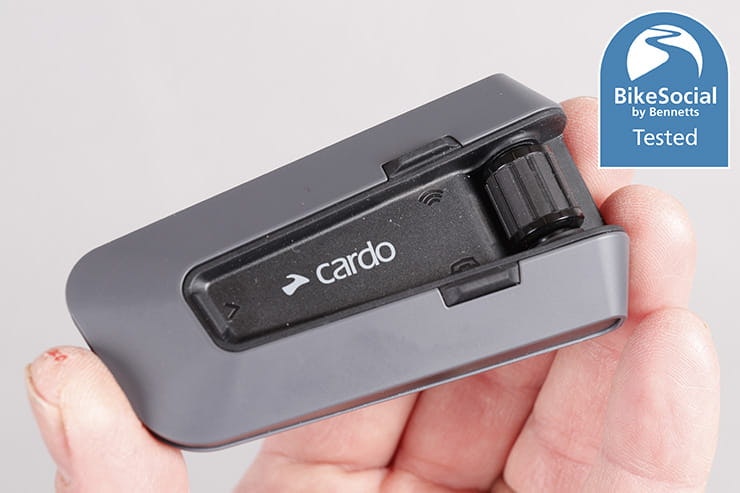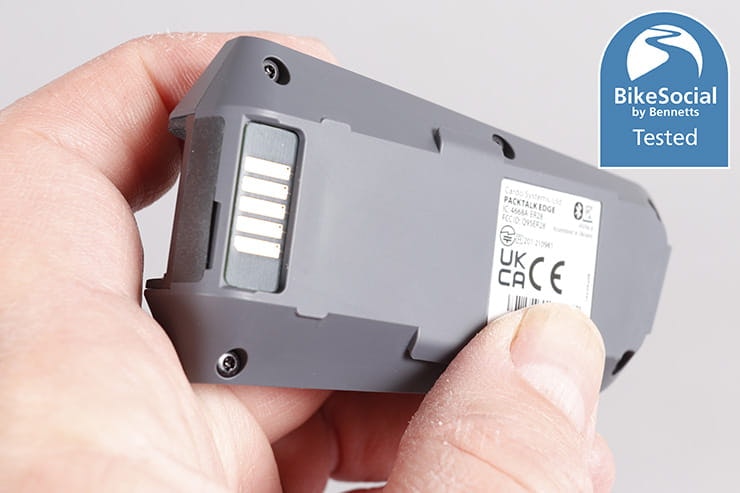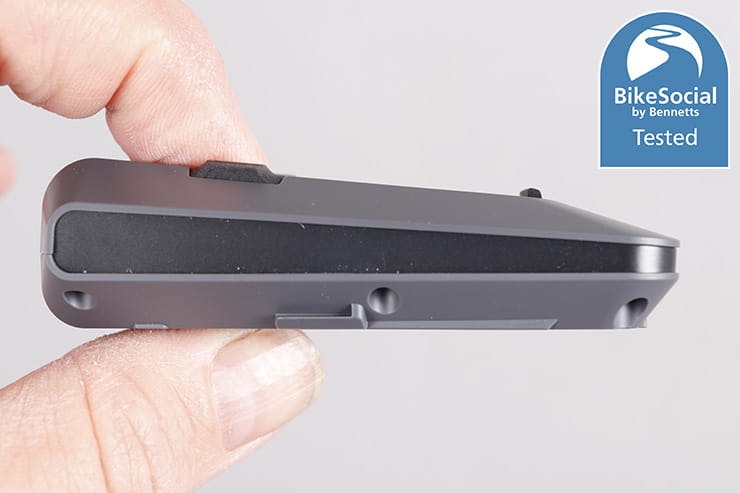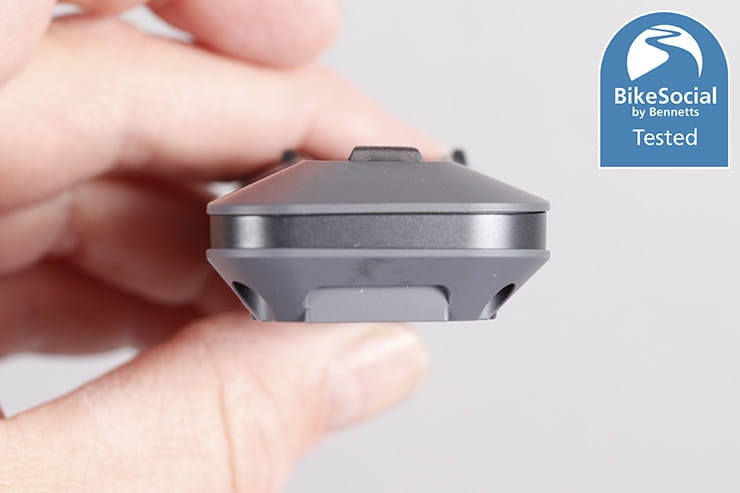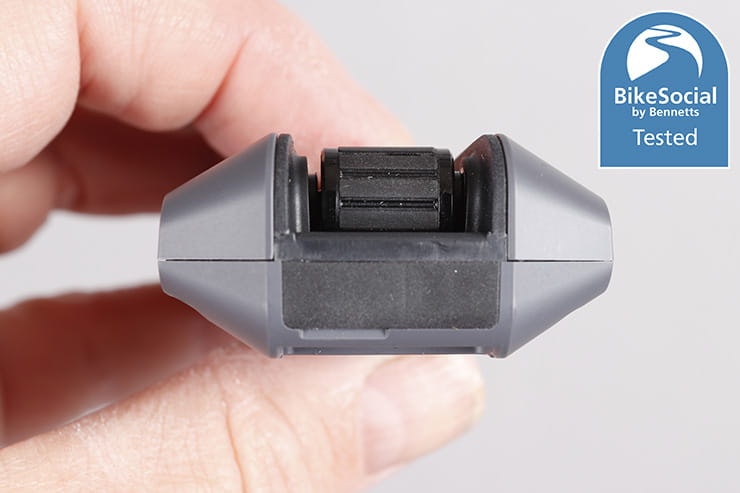Cardo Packtalk Edge review | Premium Bluetooth & mesh intercom
By John Milbank
Consumer Editor of Bennetts BikeSocial
21.06.2022
Date reviewed: June 2022 | Tested by: John Milbank | RRP: £339 | www.cardosystems.com
The Cardo Packtalk Edge on review here is the next generation from the excellent Packtalk Bold and Packtalk Black. Boasting both Bluetooth and mesh communication, as well as voice control, high-quality JBL speakers and a clever new mount, on paper it’s one of the best motorcycle intercoms. I’ve been using it with an Arai RX-7V Evo and a Shoei NXR2 while riding a BMW S1000XR and 2001 Honda VFR800 to see if it’s worth the money…
UPDATE: For the latest Cardo and Sena intercom updates, including new cross-platform compatibility, GoPro control and voice recording features, check our updates feature here.
Fantastic audio quality
Very fast phone connection
Excellent voice commands
Some false-positives with voice control
Sena’s mesh has a slight advantage
Fitting
Fitting the Cardo is as simple as any other comms unit, and thanks to the majority of helmets now having speaker cut-outs, the 40mm JBL speakers fit easily in the Arai RX-7V Evo. The Shoei NXR2 has slightly restrictive cutouts, but the off-round speakers did go in.
An adhesive mount and a simple – but effective – clip-on mount are supplied, along with a boom mic for open-face and flip-front helmets, and a stick-on mic for full-face.
Hiding the wiring is fairly simple, though the speakers use a 3.5mm TRS (tip, ring, shield – like on headphones) connector that’s a touch bulkier than it would be if a pair of the same connectors as the mic was used. While two of these are a similar overall size, when separate they’re easier to hide. Still, I’ve got everything in with this and other Cardos I’ve tested, and don’t have an issue with feeling any of the connections.
Unique to the Cardo Packtalk Edge is the new mounting system, which allows you to offer the unit up near the bracket, where it’s almost snatched out of your hands and locked securely into place with magnets fitted in both the device, and the bracket. Don’t worry – mechanical restraints also hold it in place, and removing it requires you to press the front of the bracket, then slide the device out. This will not fall out on its own.
This very clever mounting system does lose a touch of the sleek design of the others in Cardo’s range, which is a shame as they’re normally very elegant and compact.
This is the Packtalk Edge bracket, compared to the Cardo Freecom 4X
Connections
Pairing with a phone and a GPS is easy using the buttons on the Pactalk Edge, and getting your phone linked should be the first step as you can quickly and easily check for firmware updates.
I mostly use intercoms to talk to my wife, so I was surprised to find that I had to use the app to switch the Packtalk Edge to Bluetooth mode before I could pair her Freecom 1+. It’s not the end of the world by any stretch, but Sena’s 50R has fewer buttons, yet allows quick and app-free switching between Bluetooth and mesh.
Connections are generally very stable, and only when I had the intercom running live and my TomTom connected did I notice slight glitches in the music I was also streaming from my phone. This wasn’t just the odd pop or crackle you’d expect to get from another person’s intercom; it was very minor glitching to the stream.
Music and phone calls can be shared between Bluetooth Cardos once you’ve set up a ‘sharing partner’ in the app, and I generally had no problems with any of the linked devices I tested.
A recent glitch, whereby any announcements from my TomTom would be too quiet to hear for the first several seconds appear to have been ironed out, and it’s great to be able to listen to music on my own (my wife prefers quiet) while still chatting, with the two channels overlapping each-other seamlessly. When doing this, the maximum output of the music is reduced, though still very good even at motorway speeds.
Using Bluetooth 5.2, the Cardo Packtalk Edge is incredibly fast to connect to my phone – pairing almost as soon as the intercom is turned on.
Note:While Mesh can allow mulitple riders to communicate much more easily than with Bluetooth, it's important to understand that the Edge only allows up to four people to speak at a time. They can all listen, but when the fifth person speaks their unit will beep, and they'll have to wait until the line is clear before they can talk. If the mics have shut themselves down that shouldn't be a problem, but with some helmets the wind noise could keep the mics active, limiting comms.
Bluetooth vs mesh
There are now two motorcycle intercom technologies: Bluetooth and mesh.
Bluetooth can offer good range, and it remains present in all intercoms for connections to phones and sat-navs, but when pairing more than two riders together (four is usually the maximum), it’s somewhat limited in that each rider has to stay in the same physical order on the road for the connections to be stable, and if one rider does drop out, the whole group falls apart.
Bluetooth across brands works, but only to a point; I can connect a Sena to a Cardo by linking the Sena as a phone to the Cardo’s ‘universal pairing’, but sadly it’s really not ideal. Cardo has recently announced that its Spirit, Freecom X and Packtalk lines will use an ‘Open Bluetooth Intercom’ standard with Midland and Uclear, which promises to be fully compatible.
The new mesh systems, on the other hand, allow riders to change their order without breaking the chain as long as they stay within range. It’s a much more dynamic system that’s well worth investing in if you want reliable group comms.
But… mesh is not universally compatible, except in that Sena and Interphone have done a deal that means their mesh devices should work flawlessly together in future. With Cardo and Sena using different mesh systems, it’s vital that everyone in a group uses the same thing, but it’s a shame for consumers as it limits choice.
Frankly, Cardo and Sena need their heads banging together, because it’d be better for all of us if they could just play nicely together.
Note: Pairing Cardo and Sena via Bluetooth has been made pretty simple now (thanks it would appear to work by Cardo), and it is possible to create a Mesh link between them now, though I’ve not been able to thoroughly test it yet. You can find out more about pairing Cardo and Sena in this video.
Control
The Cardo Packtalk Edge has three buttons that are easy enough to index through gloves thanks to their spacing and raised form. The rear wheel is also clickable, giving a good range of options (and hence my surprise that there’s no ability to switch between Bluetooth and mesh without the app).
Playing music requires a tap of the front button, while stopping it is a press of the wheel; a lot better than the pressing of two buttons that’s required of the Spirit HD, but it’s a little frustrating to not have some continuity across the model range, at least for the most common actions.
Still, button control is almost redundant thanks to Cardo’s outstanding voice commands, which certainly betters the Senas I’ve used to date. Here’s a list of everything you can do…
The voice control really is outstanding, working even at motorway speeds, though of course if you have a particularly noisy lid or a buffetty bike, you might not get quite the same results.
One thing I have noticed is that the occasional false positive can happen. For instance, with the lid on the table, the radio kept turning on while chatting to a mate. These are unusual occurrences, and while the Cardo did keep muting itself while running the battery test that saw the speakers playing at full volume next to the mic, out on the road it’s far less common; on one 180 mile ride, the music started playing on its own while chatting to Helen on the intercom, but generally it’s pretty reliable. I haven’t noticed these ‘errors’ in recognition with previous voice-controllable Cardos, so it might be something that’s appeared while the company continues to refine the algorithm.
Volume and clarity
The Cardo Packtalk Edge’s audio quality is excellent; a combination of the Bluetooth 5.2 chip – which gives better music streaming from your phone – and the JBL-branded speakers make for some of the best bass and volume I’ve ever heard in a helmet. In fact, the only other device I’ve used that sounds as good is Cardo’s own Freecom 4X.
It’s perhaps worth noting that I’m yet to try a Sena device with the new Harman Kardon-branded speakers, but certainly compared to the HD-equipped models, Cardo has the edge.
Volume is excellent even at high speeds, and I’ve ridden on some fairly buffetty bikes. Your helmet and head shape will also all contribute, but the Packtalk Edge certainly has plenty of punch, sounding great through my EarPeace earplugs.
The iOS / Android app allows you to set one of three equaliser modes; Bass Boost, High Volume and Vocal. On this device I heard very little difference between the first two, and found no real advantage to the latter, so I’ve stuck with Bass Boost. On the Freecom 4X, the difference between Bass Boost and High Volume was more pronounced. Anyway, the point is that music sounds incredibly good.
Intercom conversation quality will depend on the wind noise in the helmets, and the buffeting from screens. With Helen as pillion, we can have clear conversations up to about 60mph on most bikes, with her using an Arai Debut.
Phone conversations are also very clear, with people calling me not believing that I’m on a motorcycle as we talk.
This test of Bluetooth and mesh range is carried out on a clear, flat, straight road
Cardo Packtalk Edge range
During my testing on a cloudy day, the Cardo Packtalk Edge had good range, reaching just short of 1,100m on Bluetooth and mesh. That’s down on the claimed 1,600m, but still impressive. Automatic reconnection of the Bluetooth intercom occurred at about the same distance as I rode back, but the mesh was less solid until about 600m. However, after several years of testing motorcycle comms I’ve learned a few very important points:
Intercoms never reach the claimed maximum range
Weather conditions make a big difference
Traffic, buildings and geography all play a part
Turning your head can lose a signal at distance
When I test any intercoms, it’s always done on the same, dead straight and flat stretch of road. My wife stands at one end with an intercom of the same model (or at least the same brand and a higher spec), then I ride off while she continues to speak. I then note when the signal cuts out, and when it reconnects.
Carbon-fibre helmets can reduce range, and cloud cover makes for a much better signal. In the real world, you can expect decent intercoms like this one to give excellent comms while you can still see the other rider.
This is a test of group mesh performance, which is carried out on a more typical rural road
Switching to mesh allows for better group intercom performance as each rider acts as a relay station, and it doesn’t matter what order they ride in. That means that, in the test example above – which had plenty of buildings and trees – Rider 1 would normally be out of range of Rider 3, but Rider 2 acts as a relay between the two. When they swap order, everything still works as normal and they can all chat to eachother. Add more to the group, and as long as each rider can hold a signal with at least one other, they’ll all maintain comms.
Cardo vs Sena mesh and Bluetooth
If you want comms between more than two people, mesh is totally worth the investment, but besides Cardo and Sena not being compatible with each-other, they also work in different ways.
Cardo’s mesh allows up to 15 riders to share a private group, whereas Sena’s system allows potentially unlimited riders to talk on an ‘open’ group. This requires no pairing, so anyone on the default open mesh mode can talk if they’re in range. You can also set up private groups too.
I can’t imagine that many riders will be hoping to talk to random strangers passing by, but Sena’s system does make it a little easier for groups to just chat as they get together. Most people though will be riding with the same people most of the time, so setting a group up is no bother. And as for the limit of ‘only’ 15 people on the Cardo… it’s unlikely – in the UK at least – that many people will need any more than that.
What is important is that, with the two brands not working together over mesh (and not seamlessly over Bluetooth), you and your friends really need to invest in the same tech.
Radio
It’s the same old story; the FM radio is fine, but nothing brilliant. It’ll give a good signal when locked on, but after about 25 miles or so it can lose grip on national stations, despite turning on RDS in the app.
Performance will vary for everyone, but nothing really stands out on the Cardo’s radio and its six programmable preset stations. When I’m riding to work, I like being able to listen to Radio 4, and it’s the excellent volume and clarity that really helps here. On longer journeys, I tend to enjoy music or podcasts, sometimes streaming from BBC Sounds, for instance.
Cardo Packtalk Edge battery life
The USB-C charging port is a welcome addition, being the most popular connection now. It’s covered by a silicone flap, and while it’s great that it’s so easy to remove the Cardo from the helmet, it is necessary in order to get a nail under there and open it. You can’t really charge this in place.
I do find the flap rather fiddly to get back into place properly – something about the design just makes it a little less willing to snap into place than other models.
Streaming music at full volume from my phone, the Cardo Packtalk Edge lasts approximately nine hours, which isn’t the best I’ve seen, though the relatively high output will no doubt have an effect on this.
During real-world use, after just under five hours of intercom chat and some music, the Packtalk Edge was at 75% battery.
Another feature I really do appreciate on the Cardo is the fact that, as you switch it off it speaks the battery level; a great reminder to charge it up if necessary.
Cardo Packtalk Edge waterproofing
The Cardo Packtalk Edge doesn’t have an official waterproof IP rating, but it is totally fine in even heavy rain thanks to the concealed connectors between the unit and bracket.
Ease of updating
Updating the Cardo Packtalk Edge is extremely easy thanks to its over-the-air system that just requires you to open the iOS / Android app. If there’s an update, you can simply tap the button and it’ll be installed quickly and fuss-free; no connecting to the computer and no special charging cables.
At the time of this review, I was using version 2.6.
Three alternatives to the Cardo Packtalk Edge
This is the top end of the market, and there are several choices. Please keep in mind that I haven’t tried the latest Interphone U-Com, Midland or UClear intercoms, but here are some others to consider…
If you don’t need mesh comms, the Cardo Freecom 4X is an excellent device that retails at £235. Read our full review here.
The 50R is the waterproof top-end device from Sena, and costs around £320. Read our full review here.
If all you really want from an intercom is good music quality and pillion use, with perhaps occasional pairings to one other rider, the Cardo Spirit HD is excellent value at £130 retail. Full review here.
These are just three of many alternatives – you can find all the intercoms we’ve tested here and be sure to regularly check for the discounts available through Bikesocial membership.
Cardo Packtalk Edge review: Verdict
The Cardo Packtalk Edge has outstanding audio quality when it comes to listening to music, excellent voice control and a good range. The mount works well, though it’s not something that Cardo really needed to improve as its previous iterations were solid, waterproof and compact.
If you want group comms then the mesh connectivity is totally worth investing in, but you do of course need to ensure that your mates have the same brand; if they’ve already got Senas, you’ll probably have to join them.
Overall this is a very high quality device with some excellent features, though make sure you’ll use them, or you could be better off investing in something lower down the range.
UPDATE: For the latest Cardo and Sena intercom updates, including new cross-platform compatibility, GoPro control and voice recording features, check our updates feature here.
